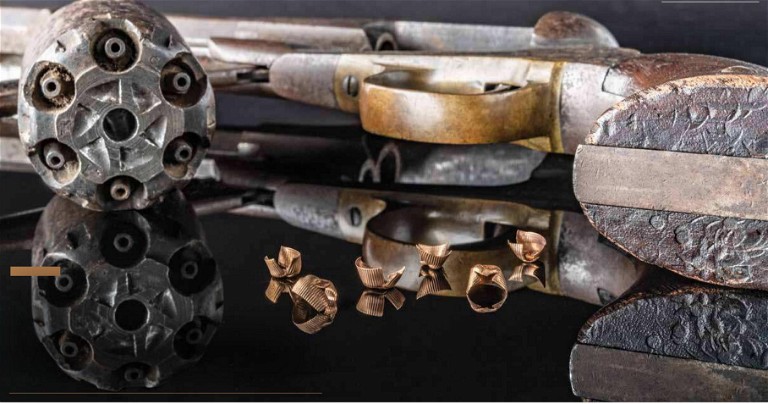TAMARA KEEL
GET HAMMERED
THERE’S NOTHING WRONG WITH A HAMMER-FIRED GUN
LEGALLY ARMED CITIZEN | IT’S JUST THE LAW BALLISTIC BASICS RETURN FIRE | CITY LIMITS

GIVE ME THAT OLD-TIME IGNITION
Hammer-fired actions are older than percussion caps, though modern hammerfired guns are a far cry from the old flintlocks and cap-and-balls like this Remington 1858.
A trend has spread among certain writers, trainers and random posters in the corners of the social media gunternet: using “striker-fired pistol” as shorthand for “modern handgun” — as though hammers on pistols are in some way bad or retrograde.
When asked why, the users tend to get a little hand-wavey, but the answers boil down into a few basic types.
There are those who insist that a striker-type ignition system is somehow newer or more advanced.
This is false. John Moses Browning’s very first commercially successful handgun, the M1899 from Fabrique Nationale, was striker-fired.
Others will insist that the single trigger pull of a striker-fired gun is easier to master. But plenty of Canik and Walther P99 shooters can tell you that just being striker-fired is not synonymous with having only one trigger pull, while shooters of 1911-pattern pistols or DAO autos only need to master the characteristics of a single trigger press.
The last group of striker acolytes exclaims, “But the 1911 has a safety!” ... to which one can point out that plenty of striker-fired autos have safeties, while numerous hammer guns do not.
The pros and cons of the two ignition systems are at once simpler and more nuanced than these replies. In the most basic terms, a striker ignition system is less complicated and less expensive to make. A hammer-fired system is more expensive but will generally have greater ignition reliability in exchange for the increased parts count. This is partially due to the fact that the combined inertia of a hammer and firing pin is more massive than the typical striker. Additionally, the hammer can be powered by a big spring in the pistol’s grip rather than a bitty little one in the pistol’s striker channel.
There is one other place that the hammer offers an advantage, however, and it has made possible two of the most popular types of concealed carry pistols on the market right now. Basically, the hammer itself serves as an additional brake on the rearward motion of the slide.
With a striker-fired pistol, such as a Glock or P365, the only elements retarding the rearward motion of the slide are the mass of the slide itself, the tension of the recoil spring and the mechanical disadvantage of “unlocking,” or decoupling the tilting barrel from the slide.
Lost in all of this is the effort taken to cock the striker spring, which is not a whole lot more substantial than the one in a good ballpoint pen.
Traditional pocket pistols in the 20th century, chambered in calibers such as .25 ACP and .32 ACP, were usually blowback-operated and mostly striker-fired, meaning they didn’t even have the mechanical disadvantage of unlocking the barrels to slow the slides. As a result, chambering anything larger than .25 in such a gun required either a fairly massive slide or a heavy recoil spring to keep the slide from opening before the bullet left the barrel and chamber pressures had dropped to a safe level.
It was KelTec that combined numerous existing techniques that allowed serious miniaturization of the pocket auto.
The resulting string of .32 and then .380 pistols basically drove the old .25 ACP “mouse gun” out of existence.
None of these technologies were revolutionary (which is why none of these features were patented and copycats quickly appeared). KelTec simply combined tilting-barrel, short-recoil operation, which added a mechanical disadvantage that the slide had to overcome before moving rearward, with a hammer-fired ignition system. This meant that the slide also had to override the hammer and mainspring before it could be completely freed to move to the rear. To get an idea of how much braking force is added by the presence of a hammer, simply compare how much less force is required to run the slide on a hammer-fired gun when the gun is cocked versus when it isn’t.
If there was any innovation on the part of KelTec, it was in using a system where the hammer itself was always cocked while the mainspring was partially at rest. This way, administrative manipulation of the pistol didn’t always require fighting the hammer. (This is why, for example, the original P3AT doesn’t have re-strike capability on a recalcitrant primer and why the true DAO Smith & Wesson Bodyguard 380 has a heavier trigger pull.) The presence of a hammer is also crucial to the currently popular pistols marketed with easy-to-manipulate slides, epitomized by the EZ series from Smith & Wesson.
While they may resemble their striker-fired stablemates in external shape, under the hood, they are very different, featuring a single-action, hammer-fired action. The cocked hammers hidden inside these pistols mean that a much lighter recoil spring can be used, allowing people with physical challenges to more easily operate the slides. Additionally, these sorts of pistols tend to have grip safeties and thumb safeties because there ain’t no such thing as a free lunch.
So don’t be so quick to dismiss hammers as anachronisms. They’re just another way of busting a cap, and they have advantages and disadvantages all their own.